Auditioning – What It’s Like “In The Room Where It Happens”
Spotlight welcomes guest blogger and current PYT actress Samantha Belding!
Hi! My name is Samantha Belding and I have been participating in Peninsula Youth Theatre musicals since the production of Les Miserables in 2015. PYT is such a fun and welcoming place for new actors. Everyone has always been kind and helpful but there are a few things I wish I would have known when I first started auditioning. Here are a few tips that might help new actors feel more at ease during the audition process at PYT.
Enjoy the moment and embrace feedback!
First, be sure to have fun! If you are not having fun, then it will show during an audition, and therefore, on stage. Being part of a PYT Main Stage production is definitely hard work, but regardless of the role you receive, it should be an extremely fun and rewarding experience. Each show begins with the audition— so have fun and enjoy the moment. This is your chance to shine!

Each Auditioner Receives a Number
If you want specific roles, you are going to have to work hard and be open to constructive criticism. A valuable tool is having “trusted advisors” (usually family members or close friends) who you can count on to give you honest and helpful advice. For example, if I sang for my Grandma, she would never tell me if I missed a note or if my voice was flat. There is nothing wrong with that (I love you, Grandma!), but it is helpful to find someone who can be brutally honest.
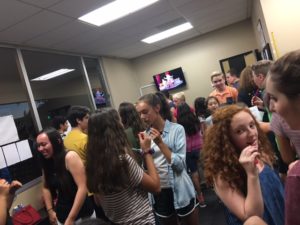
PYT Lobby Full of Auditioning Actors!
Audition prep & what to expect
For every PYT show, you will need to prepare a one-minute song and a one-minute monologue. The casting crew will bring you into a big room (ten actors at a time) to perform your pieces. The other nine actors in your group are selected based on the order and timing in which they signed up for an audition slot. Therefore, you could end up auditioning right after someone who has played the lead role in Mary Poppins or after someone who has never performed in public before. In my experience, there are usually about two to five people (director, vocal director, choreographer, etc.) seated behind a long table watching the actors audition. They are always supportive and respectful during your audition and they are the people who will decide which actor will be playing what role in the show.
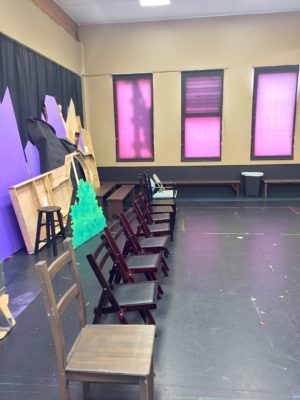
Audition room – take a seat and wait your turn!
Monologue tips and tricks
When choosing a monologue, make sure you consider the type of show for which you are auditioning. For example, if you are auditioning for a fun and silly musical such as PYT’s version of Cinderella, a happy and upbeat monologue would be perfect. However, if you are auditioning for a sad and heavy show like Les Miserables, a dramatic monologue would be more appropriate. You can help the casting crew picture you as a character in the show if your audition choices are similar to the tone and style of that show.
When preparing for an audition, make sure you get ready far in advance so you have time to practice. Once you have your monologue memorized, it helps to break it down and figure out what every line means. This will help you better understand how the character feels and make your performance stronger. Pick a monologue that is true to who you are and that means something to you.

Kids at a Stories-On-Stage Audition
Here are a few simple tips that can help when reciting your monologue during auditions:
Pick a focal point! A focal point is a spot on the wall that you look at when reciting your monologue. The casting crew wants to see you act as if you are on stage, so instead of looking the crew in the eyes during your monologue, look directly at the wall above them. Imagine that spot is the person who you’re talking to. If it is a more complex monologue, or you are talking to multiple people, sometimes you can choose a few different focal points.
Stay on time! Another very important tip for your monologue is to time it beforehand. Both your song and monologue are required to be under one minute each and, believe me, the casting crew will cut you off! There is someone sitting at the table with a timer and he or she will tell you to stop if you go over time. In one of my first auditions, my song ran only a few seconds over time, but I was stopped before I could finish. It was a little uncomfortable, so make sure you keep your pieces under a minute!
Move around a little! Sometimes monologues can get boring if you stay in the same spot during the entire audition. You have to figure out beforehand the best times to move, rehearse these actions so they don’t look messy when the audition comes around. In addition, when you move, you have to move with purpose. Have a reason to move. Move according to what your character is saying in your monologue.
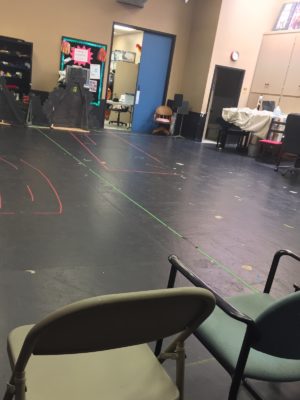
Studio A – The Audition Room
Choosing the right audition song
Choosing a song can be just like choosing a monologue: make sure you consider the show that you are auditioning for, your vocal range, and how much you like the song. Never choose a song from the show for which you are auditioning, however the song should be in the same style of the show.
Dancing through life
In dance auditions, the key is to be confident. I always aim to find a spot in the front during dance auditions whenever possible. I’m not the greatest dancer, but dancing in the front shows that you are confident enough to dance right in front of the directors and it lets them see your dancing much more clearly. When you learn the dance for the first time, don’t be afraid to ask questions. Whoever is teaching you will always be happy to help.
After you learn the dance, the teacher will usually split you up so you can practice with a smaller group. A helpful tip: When a different group is dancing, do not just stand to the side or chat with a friend. This is a perfect time to review the dance!
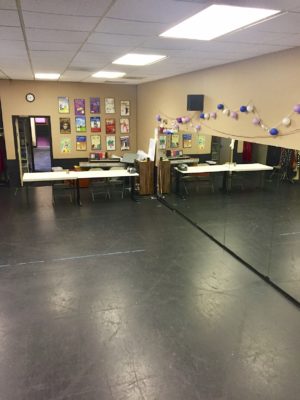
Studio B – where you learn the dance audition choreography.
Callbacks: Act II of the audition
After auditions, actors are told to stick around while the casting crew evaluates the audition performances and determines which actors should receive a callback. A callback is kind of like a second audition, where the director wants to see you for a more specific role.
Many actors, including myself, tend to overthink callbacks and get much too worried about them. However, callbacks do not always determine the role you get. For example, you might not receive any callbacks, only because they may already be considering you for a specific role. On the other hand, you may receive multiple callbacks for various roles, but end up not being cast in any of them.
The actual callbacks are a lot like the auditions. The only difference is that the casting crew sends you a “side” to memorize if you are singing or acting. A side is a few lines, a scene, or sheet music for a part of a song. You usually have only a few days to prepare your side before the callback.
I hope these tips and tricks will help you during your next audition. Theatre is a place where you should be comfortable and happy. Remember that your fellow actors, the directors, choreographers, and everyone at PYT will support you and they want you to succeed.
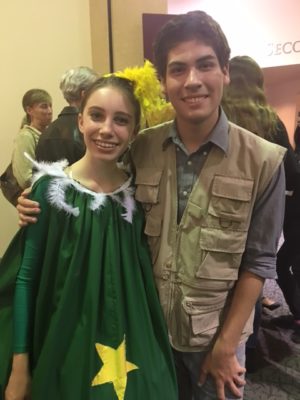
Samantha with Fellow Actor Braden
Photos by Barbie Koch and Samantha Belding









Impressive detailed and helpful advice from a young PYT participant. Even those who have been in PYT productions could benefit from reading it.